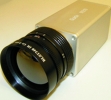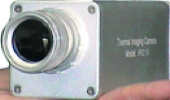

In the October 2004 issue of this publication, reference was made to the use of thermal imaging cameras to supplement the conventional visible imaging cameras.
Such a camera was recently released in the UK and makes use of a state-of-the-art amorphous silicon microbolometer in the form of a 320 x 240 pixel array and images in the 8 to 14 µ waveband. The use of infrared radiation of this wavelength eliminates the need for any illumination and similar imagery is observed 24 hours a day. This camera, designated the IR210, is extremely compact and weighs a mere 220 g with dimensions of 120 x 60 x 60 mm (without the lens). The camera can be easily integrated into an existing CCTV network and video output is in either PAL or NTSC format. Operating temperature range covers -20°C to 50°C and the supply voltage required is between 7 and 9 V d.c. with power consumption being some 3,5 W. The camera interface is RS232/RS485 and gain can be controlled manually or automatically. An electronic zoom is built in and although the image is monochrome, false colour is an option. Naturally the camera is fully waterproof.

Depending on application (field of view and range) a full range of infrared lenses ranging from 19 mm (f/0,7) to 150 mm (f/1,4) is available.
A handheld version of this camera, the IR512+, is also available, which with a 90 mm f/1 lens, and the display provided on a CRT viewfinder, can track vehicles at distances in excess of 3 km through smoke or fog.
For more information contact MIT, 012 348 0569, [email protected]
© Technews Publishing (Pty) Ltd. | All Rights Reserved.